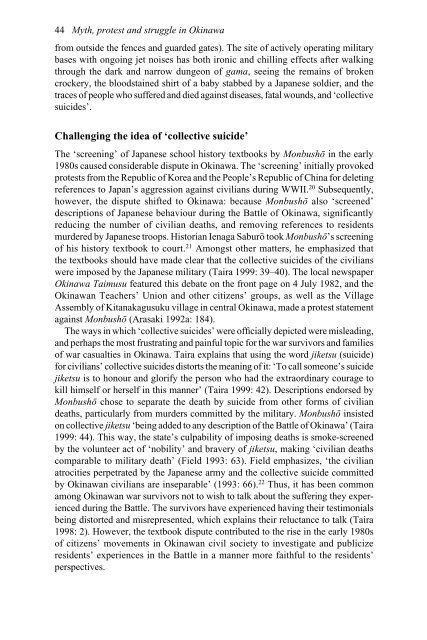Myth, Protest and Struggle in Okinawa
Myth, Protest and Struggle in Okinawa
Myth, Protest and Struggle in Okinawa
Create successful ePaper yourself
Turn your PDF publications into a flip-book with our unique Google optimized e-Paper software.
44 <strong>Myth</strong>, protest <strong>and</strong> struggle <strong>in</strong> Ok<strong>in</strong>awa<br />
from outside the fences <strong>and</strong> guarded gates). The site of actively operat<strong>in</strong>g military<br />
bases with ongo<strong>in</strong>g jet noises has both ironic <strong>and</strong> chill<strong>in</strong>g effects after walk<strong>in</strong>g<br />
through the dark <strong>and</strong> narrow dungeon of gama, see<strong>in</strong>g the rema<strong>in</strong>s of broken<br />
crockery, the bloodsta<strong>in</strong>ed shirt of a baby stabbed by a Japanese soldier, <strong>and</strong> the<br />
traces of people who suffered <strong>and</strong> died aga<strong>in</strong>st diseases, fatal wounds, <strong>and</strong> ‘collective<br />
suicides’.<br />
Challeng<strong>in</strong>g the idea of ‘collective suicide’<br />
The ‘screen<strong>in</strong>g’ of Japanese school history textbooks by Monbushō <strong>in</strong> the early<br />
1980s caused considerable dispute <strong>in</strong> Ok<strong>in</strong>awa. The ‘screen<strong>in</strong>g’ <strong>in</strong>itially provoked<br />
protests from the Republic of Korea <strong>and</strong> the People’s Republic of Ch<strong>in</strong>a for delet<strong>in</strong>g<br />
references to Japan’s aggression aga<strong>in</strong>st civilians dur<strong>in</strong>g WWII. 20 Subsequently,<br />
however, the dispute shifted to Ok<strong>in</strong>awa: because Monbushō also ‘screened’<br />
descriptions of Japanese behaviour dur<strong>in</strong>g the Battle of Ok<strong>in</strong>awa, significantly<br />
reduc<strong>in</strong>g the number of civilian deaths, <strong>and</strong> remov<strong>in</strong>g references to residents<br />
murdered by Japanese troops. Historian Ienaga Saburō took Monbushō’s screen<strong>in</strong>g<br />
of his history textbook to court. 21 Amongst other matters, he emphasized that<br />
the textbooks should have made clear that the collective suicides of the civilians<br />
were imposed by the Japanese military (Taira 1999: 39–40). The local newspaper<br />
Ok<strong>in</strong>awa Taimusu featured this debate on the front page on 4 July 1982, <strong>and</strong> the<br />
Ok<strong>in</strong>awan Teachers’ Union <strong>and</strong> other citizens’ groups, as well as the Village<br />
Assembly of Kitanakagusuku village <strong>in</strong> central Ok<strong>in</strong>awa, made a protest statement<br />
aga<strong>in</strong>st Monbushō (Arasaki 1992a: 184).<br />
The ways <strong>in</strong> which ‘collective suicides’ were officially depicted were mislead<strong>in</strong>g,<br />
<strong>and</strong> perhaps the most frustrat<strong>in</strong>g <strong>and</strong> pa<strong>in</strong>ful topic for the war survivors <strong>and</strong> families<br />
of war casualties <strong>in</strong> Ok<strong>in</strong>awa. Taira expla<strong>in</strong>s that us<strong>in</strong>g the word jiketsu (suicide)<br />
for civilians’ collective suicides distorts the mean<strong>in</strong>g of it: ‘To call someone’s suicide<br />
jiketsu is to honour <strong>and</strong> glorify the person who had the extraord<strong>in</strong>ary courage to<br />
kill himself or herself <strong>in</strong> this manner’ (Taira 1999: 42). Descriptions endorsed by<br />
Monbushō chose to separate the death by suicide from other forms of civilian<br />
deaths, particularly from murders committed by the military. Monbushō <strong>in</strong>sisted<br />
on collective jiketsu ‘be<strong>in</strong>g added to any description of the Battle of Ok<strong>in</strong>awa’ (Taira<br />
1999: 44). This way, the state’s culpability of impos<strong>in</strong>g deaths is smoke-screened<br />
by the volunteer act of ‘nobility’ <strong>and</strong> bravery of jiketsu, mak<strong>in</strong>g ‘civilian deaths<br />
comparable to military death’ (Field 1993: 63). Field emphasizes, ‘the civilian<br />
atrocities perpetrated by the Japanese army <strong>and</strong> the collective suicide committed<br />
by Ok<strong>in</strong>awan civilians are <strong>in</strong>separable’ (1993: 66). 22 Thus, it has been common<br />
among Ok<strong>in</strong>awan war survivors not to wish to talk about the suffer<strong>in</strong>g they experienced<br />
dur<strong>in</strong>g the Battle. The survivors have experienced hav<strong>in</strong>g their testimonials<br />
be<strong>in</strong>g distorted <strong>and</strong> misrepresented, which expla<strong>in</strong>s their reluctance to talk (Taira<br />
1998: 2). However, the textbook dispute contributed to the rise <strong>in</strong> the early 1980s<br />
of citizens’ movements <strong>in</strong> Ok<strong>in</strong>awan civil society to <strong>in</strong>vestigate <strong>and</strong> publicize<br />
residents’ experiences <strong>in</strong> the Battle <strong>in</strong> a manner more faithful to the residents’<br />
perspectives.
















